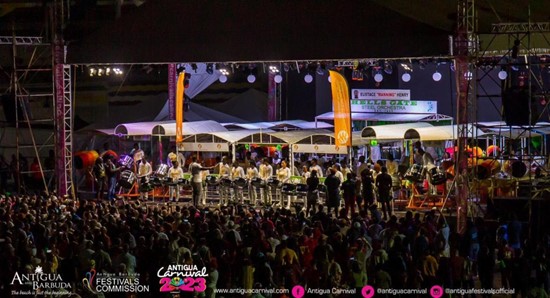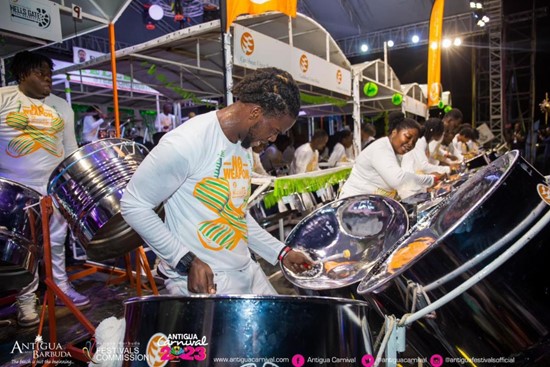
The Panorama Steelpan Orchestra competition returned to the vibrant capital of Antigua (St. John’s) this August for the first time since 2019 and the joyful sounds of steelpan were once again heard all around town. Although the competition had been postponed for a couple of years, the legacy of steelpan music ensured that this quintessentially Caribbean experience remained a vital part of day-to-day life in Antigua. Whether occurring spontaneously via a solo street performer or courtesy of a full orchestra with more than a hundred musicians, rehearsals and performances are a welcome and prominent facet of life on the island. The largest performances can feature up to 110 musicians (called ‘pannists’) - an incredible figure that only speaks to the communal appeal of this treasured musical tradition.
On any given night, certain restaurants and venues will feature steelpan bands as part of the entertainment. With eight big orchestras on the island, competition is intense, although all the players know each other and support each other’s efforts in the friendliest manner. In many ways, steelpan reflects the warm and inviting character of Antigua and Barbuda itself!
This modern art form has a fascinating history, stretching back decades. Where exactly did steelpan start and why is Antigua one of the best places in The Caribbean to listen in? We answer both of those questions in this newsletter, below.

The Origins of Steelpan
Centuries ago, enslaved people on larger plantations would entertain themselves by striking bamboo sticks together. Cut to various lengths, they could create a tuneful, percussive effect. Later, this practice evolved into the use of biscuit tins of various sizes and chunks of iron that were found to create different notes. Discarded brake drums and car wheel rims became favourite choices. Eventually, the impromptu bands became known as steel bands.
Then in the mid-1940s, a musician in Trinidad had the idea of using discarded 55-gallon oil drums from the island’s nascent oil and tar industries to create a unique instrument. Marking the steel on the top of the drum into separate spaces, while patiently thinning the steel by repetitive hammering and heating, created a distinctive range of notes. Cutting the sides of the oil drums to different heights also affected the sound and timbre. The idea took off and Trinidad quickly became known for these so-called steel pans, which could be tuned into a variety of scales. Because they were fashioned from oil drums, some people started calling them steel drums, but the players themselves disdain this nomenclature, as to be correctly called a drum, the instrument has to have a membrane.
Originally, pans were a solo instrument, supported around the pannist’s neck by a strap, but that quickly evolved into a standing instrument, tuned in a great variety of combinations to create popular calypso and Soca music. As the range of notes possible on each pan increased, so too did the number of pans a pannist could play. Some handle as many as 10 pans at once, set up in a huge array around them. Two or four are very common.

Defining The Antiguan Sound
At the same time as steelpan music was developing, itinerant labourers from Antigua were travelling by boat around the Caribbean in search of work and frequently found themselves transiting through Trinidad. They enthusiastically brought the musical concept back home with them, where its popularity immediately took off. Players in what would become the famous Hells Gate Steel Orchestra had already been making music with old bits of iron found on the solid waste dump, such as automotive clutch housings, hollow pipes, biscuit tins, discarded hub caps and baking pans, or pieces of solid scrap iron acquired from the local blacksmith. They took to the new instrument enthusiastically, immediately saw its potential and formed a steel band in 1945. Hells Gate is now the longest-continuously performing steel band in the world, adopting its present name in 1947. As the number of musicians grew to over a hundred, the largest steel bands began to call themselves steel orchestras. At this August’s Panorama competition, Hells Gate once again commanded the leading position, taking first for the fourth consecutive time, with an all-time total of 22 wins.

Notably, steelpan in Antigua is an extremely youthful venture. The average age of the pannists is about 20, with very few over 40 and some prodigies as young as five years old. The senior members of the troupe are the captain, who guides the entire ensemble and may act as a conductor, and the builder and tuner, who makes and tunes the instruments. The popularity of steel bands amongst the younger demographic speaks to the enduring appeal of this thriving musical scene - and guarantees another competitive Panorama next year!
Of course, you don’t have to be a member of Hells Gate to get in on the fun. The good news for visitors is that the orchestra now offers regular tuition sessions. Registration with The Eustace Manning Henry Steelpan Academy began in early September at the Hells Gate Steel Orchestra pan yard located on Bay Street. There is also talk of an immersive 14-day program creating an educational experience for steelpan, calypso and Caribbean music and history.
Learn more about the sounds (and sights) of Antigua and Barbuda at https://www.visitantiguabarbuda.com/.


